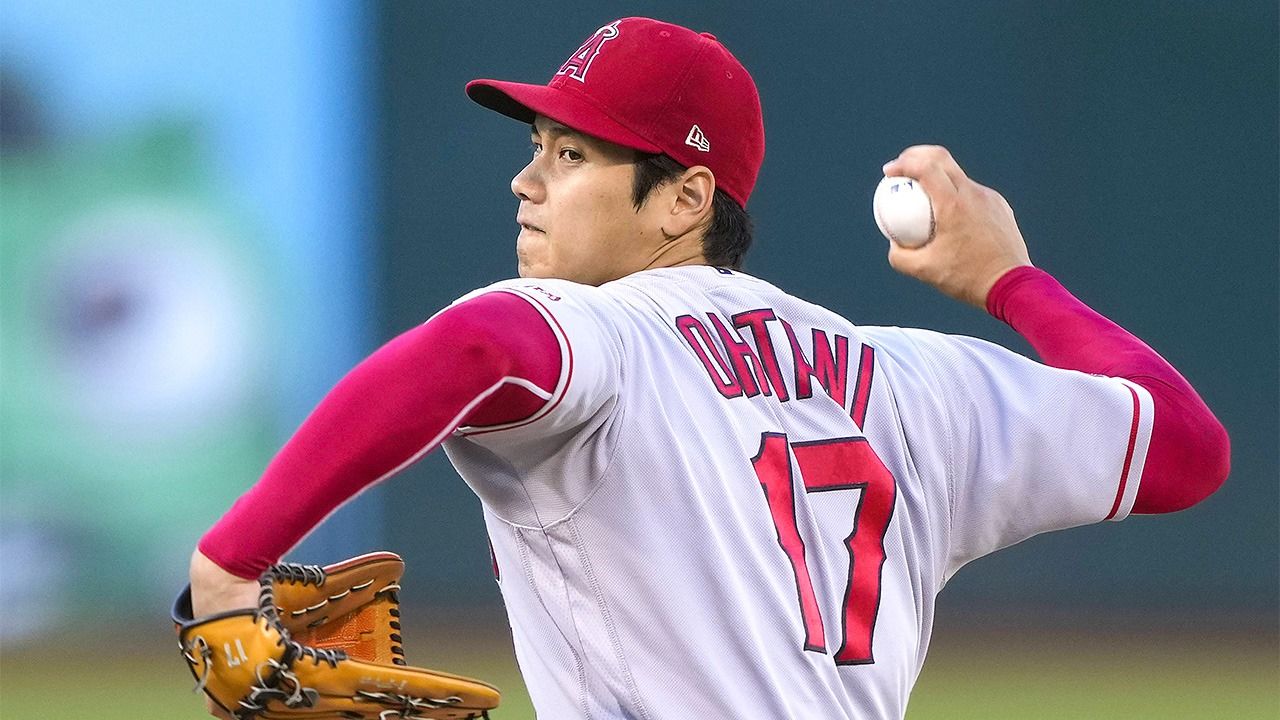
“Yakyū” Nation: Celebrating 150 Years of Japanese Baseball
Sports History- English
- 日本語
- 简体字
- 繁體字
- Français
- Español
- العربية
- Русский
Baseball Arrives in Japan
The Meiji Restoration in 1868 ended Japan’s long feudal isolation and started the country on the path to modernization. As the government eagerly adopted Western institutions and culture, new thoughts and ideas flowed into the country, including the previously unknown concept of sports. Japan boasted ancient martial arts traditions like jūdō, kendō, and kyūdō (Japanese archery), but these were not athletic pursuits that average citizens participated in or watched for recreation.
Foreign teachers recruited to instruct Japanese students at newly established secondary education institutes are generally credited with introducing Western sports to Japan. Baseball was among the first of these to reach the nation’s shores, brought by the American educator Horace Wilson, who in 1872 taught the game to his students at Kaisei Gakkō (now the University of Tokyo).
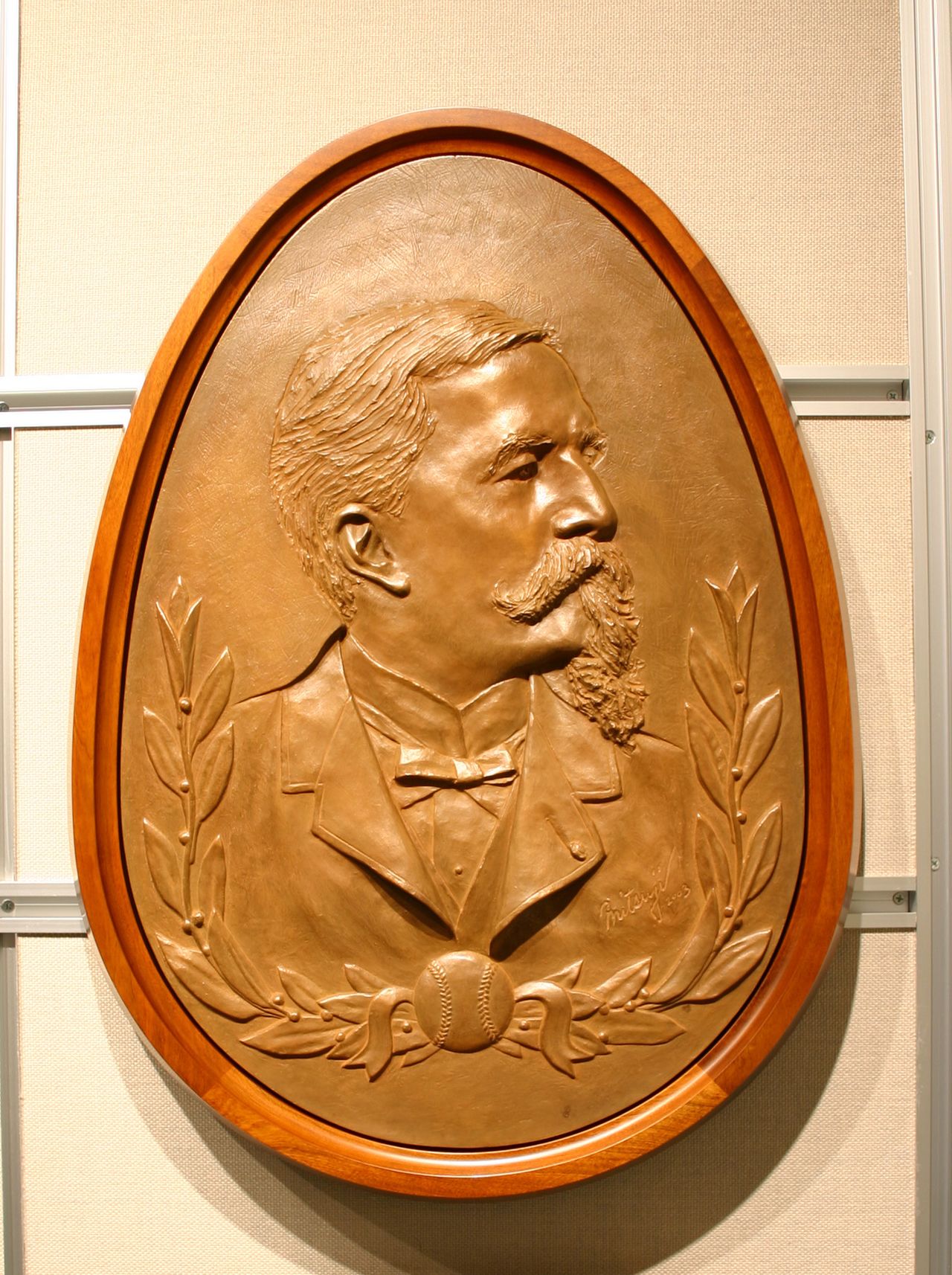
A plaque commemorating American teacher Horace Wilson hangs at the Baseball Hall of Fame and Museum in Bunkyō, Tokyo. (Courtesy of the Baseball Hall of Fame and Museum)
Students at elite prep schools like First Higher School of Tokyo, Meiji Gakuin, Keiō, and Waseda embraced baseball, with rivalries among these teams helping bolster the sport’s reputation. The popularity of baseball, called yakyū—literally “field ball”—in Japanese, eventually spread to the general public, growing over time into a national obsession.
Yakyū and the Media
Newspapers were quick to recognize baseball’s potential and were pivotal in fueling public interest in the sport by sponsoring national high school championships. The first of these, backed by the Osaka-based Asahi Shimbun, started in August 1915. Taking advantage of summer holidays, the tournament brought together the winning schools from each of the prefectural tourneys. A rival paper, the Mainichi Shimbun, launched its own national tournament in April 1924. Held during the spring break between school years, the invitational featured first- and second-year players, with schools being invited to participate based on their showing during the autumn season.
Since opening in 1924, Kōshien Stadium, now the Hanshin Kōshien Stadium, in Hyōgo Prefecture has hosted the summer and spring tournaments. The summer competition in particular has come to be seen as the pinnacle of high school baseball, and even to represent the purest embodiment of the sport—something that all youth players aspire to. The spring tournament is also a major sporting event that is closely followed by the public.
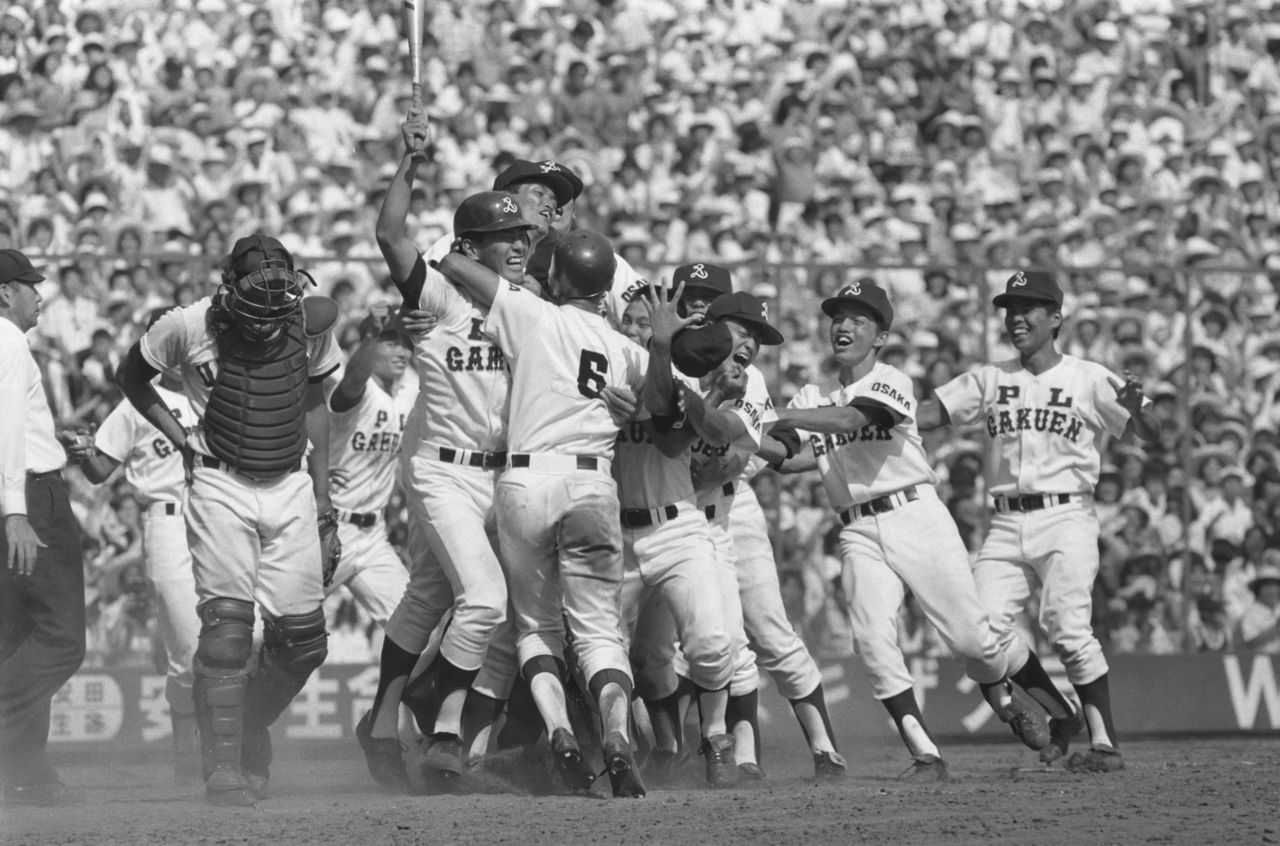
Players of powerhouse PL Gakuen Senior High School celebrate winning the summer installment of the national baseball championship, the school’s third title, at Kōshien Stadium on August 21, 1985. (© Jiji)
Newspapers provided in-depth coverage of the tournaments, which played a pivotal role in popularizing baseball among the public. Along with printing the box scores of games, papers appealed to readers with features on the different teams and offered human interest pieces highlighting local support of schools. Live radio broadcasts of the tournaments, first aired in March 1925, added to baseball’s allure.
That year also saw the inaugural intercollegiate league featuring teams from Tokyo’s most prominent universities—Waseda, Keiō, Meiji, Hōsei, Rikkyō, and the University of Tokyo. Games in the Tokyo Big Six University Baseball League were held at Tokyo’s Meiji Jingū Stadium, and the competition quickly drew the interest of baseball fans for its high level of play, including the appearance of former high school stars. Matchups between rivals Waseda and Keiō were showcase events and even garnered national media coverage.
The Babe and the Start of Professional Baseball
The Yomiuri Shimbun jumped on the baseball bandwagon in 1931 by sponsoring a series of games between collegiate standouts from the Big Six league and elsewhere and an American all-star squad featuring Major League players like Lou Gehrig and Lefty Grove. The tour was a huge success despite the absence of Babe Ruth, with crowds flocking to games in droves. Ruth was on the roster for the 1934 tour, also sponsored by the Yomiuri, against a team of Japanese amateur stars—the Ministry of Education had barred college players, deeming the games professional contests.
The Japanese squad consisted of former university standouts like Mihara Osamu, Mizuhara Shigeru, and Tabe Takeo, along with pitching prodigy Sawamura Eiji and Russian-born Victor Starffin. Seeing Ruth in action was a huge thrill for Japanese spectators, who delighted as much in his 13 home runs as his humorous antics, including famously taking the field in the pouring rain with a Japanese-style umbrella propped on his shoulder. Japanese were so smitten with the American star that US Ambassador to Japan Joseph Grew quipped that Ruth was far and away a more effective envoy.
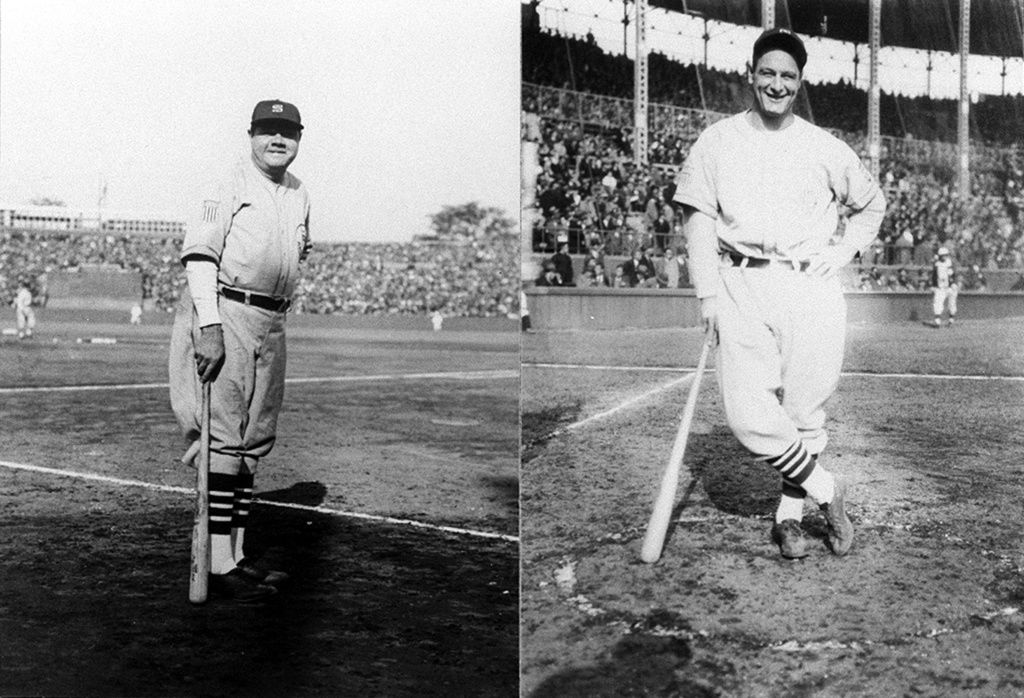
Babe Ruth, left, and Lou Gehrig during the 1934 American Major League all-star tour of Japan. (© Kyōdō)
Many of the players on the Japanese squad went on to join Japan’s first professional team, the Dai Nippon Tōkyō Yakyū Kurabu (Great Japan Tokyo Baseball Club). While touring the United States, the team changed its name to the less cumbersome Tokyo Giants. In February 1936, the Giants were joined by corporate-sponsored clubs based in Tokyo, Nagoya, and Osaka to form the country’s first professional grouping, the seven-team Japanese Baseball League.
Wartime Influence
Still in its infancy, professional baseball in Japan struggled through the war years. With the start of the Second Sino-Japanese War in 1937, players left teams to join the war effort and were sent to the front lines to fight, sapping clubs’ strength. Deteriorating relations with the United States cast baseball in a negative light and sparked an all-out effort to purge any foreignness from the sport, including a ban on American terminology. Words like safe, out, and strike were swapped for native terms, and teams with English names changed these to Japanese—the Osaka Tigers became the Mōkogun (fierce tigers) and the Kōrakuen Eagles were renamed the Kurowashi (black eagles). As Japan’s momentum in the conflict waned, these efforts grew even more bizarre, including players trading their baseball hats for military field caps and the appearance of a pregame ritual where a hand grenade was lobbed at a sign bearing the message “Death to America and Britain.”
The professional league, renamed the patriotic-sounding Nippon Yakyū Hōkokukai, limped along until its final competition in September 1944, after which it suspended its activities indefinitely. Tokyo’s Big Six League had already disbanded, and the halt of professional games was the death knell of organized baseball during the war years.
Then on August 15, 1945, the emperor notified the nation of its total defeat in his historic “jewel voice broadcast.” As the country set about rebuilding itself from the ashes of war, there was little beyond radio and baseball in the way of public entertainment, and Japan quickly rekindled its obsession with yakyū. A mere two months after the war, alumni of the Big Six schools organized a game at Meiji Jingū Stadium, renamed Stateside Park by the US occupation forces, that attracted a capacity crowd hungry for the sport.
The US-led Allied High Command saw the advantage in backing Japan’s baseball revival and sought to use the game, along with the role of the emperor, to further its cause. Spurred on by the resumption of professional baseball, university leagues, and high school tournaments, the popularity of yakyū soared to new heights.
A Golden Age on the Diamond
Amateur baseball, in the form of the Big Six League and spring and summer high school competitions at Kōshien Stadium, retained its public appeal. The professional game lagged, but took off with the arrival of Nagashima Shigeo, a top player for Rikkyō University who signed with the Tokyo Yomiuri Giants. Although he famously went 0–4 against ace pitcher Kaneda Masaichi in his debut for the team, Nagashima quickly rose to be a superstar with his earnest style of play. He was joined a year later by Waseda Jitsugyō High School standout Oh Sadaharu, with the duo forming the “ON cannon” consisting of Nagashima batting third followed by Oh at cleanup. A rivalry arose between the Giants and the Hanshin Tigers, who boasted pitching sensations Murayama Minoru and Enatsu Yutaka. But it was the Tokyo sluggers and their teammates who dominated media coverage.
Leading the way with press exposure was the Giant’s corporate sponsor, the Yomiuri media conglomerate, which ran stories about the club in its namesake paper as well as its subsidiary Hōchi Shimbun, a former daily that had reinvented itself as a sports newspaper. The spread of television boosted the Giants’ fame as fans eager to see Oh and Nagashima in action tuned into Yomiuri affiliate Nippon Television, which held sole broadcasting rights to the team’s home games at Kōrakuen Stadium. Japan’s economy had entered a period of rapid growth, and catching a night game on the TV set while sipping cold beer became a postwork ritual for the burgeoning population of businessmen.
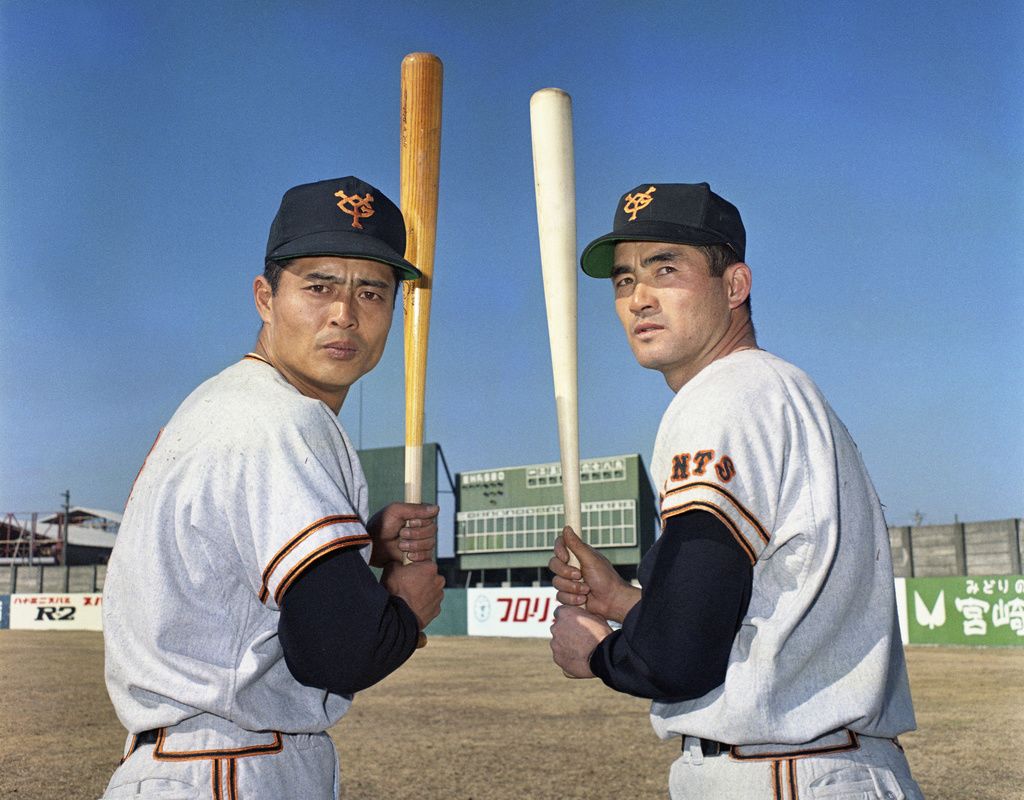
Oh Sadaharu, left, and Nagashima Shigeo pose together at the Miyazaki Prefectural Baseball Stadium on February 15, 1970. (© Kyōdō)
The Giants were unstoppable during the Oh-Nagashima era, with club winning nine straight Japan Championships under manager Kawakami Tetsuharu. Having helped establish the Giants dynasty, Nagashima went on to retire with full honors, followed close behind by Oh.
Professional baseball underwent a host of changes in the following decades. The Giants’ dominance eventually waned, making way for clubs like the Hiroshima Carp and Yakult Swallows to claim their first titles. Teams changed names and cities, including the Seibū Lions, once the Nishitetsu Lions, and Fukuoka SoftBank Hawks, formerly the Nankai Hawks. Nippon Ham moved from Tokyo to Hokkaidō, and the Kintetsu Buffalos merged with the Orix BlueWave, making room for a brand-new franchise, the Tōhoku Rakuten Golden Eagles.
Big-League Dreams
Japanese professional baseball players flaunted their skills for fans at home, but few ever dreamed of plying their trade in the North American Major Leagues. The first to cross the pond was pitcher Murakami Masanori, who in 1964 earned a spot as a reliever on the San Francisco Giants after joining the club’s farm team on a “baseball exchange.” Murakami would return to Japan the following year, and it would be three decades before another Japanese player, the pitcher Nomo Hideo, followed in his footsteps.
Nomo moved to the Los Angeles Dodgers in 1995 under a cloud. Dissatisfied with his team, the Kintetsu Buffaloes, and in particular manager Suzuki Keishi, he headed for the Major Leagues, where he surpassed all expectations. Utilizing his iconic “tornado” windup, he vexed batters with his fastball and forkball. He finished his rookie season with the Dodgers 13–6 and led the National League in strikeouts with 236. His exploits on the mound earned him a trip to the MLB All-Star Game and the Rookie of the Year Award.
Everything changed after Nomo. MLB teams quickly recognized the merits of Japanese players, who along with offering real talent on the mound were also adept at basics like executing pickoffs and covering bases. Furthermore, they were upstanding in their behavior on and off the field—drug and alcohol abuse wasn’t an issue—drew fans to stadiums, and brought in lucrative broadcasting contracts.
Although pitchers made up the first wave of Japanese talent to the Major Leagues, Suzuki Ichirō proved that position players also had what it takes—in addition to bringing in greater television revenue by appearing in more games. Ichirō had expressed strong interest in playing in the United States, but his team, the Orix BlueWave, were reluctant to let their star player go. Ichirō had two seasons left before he would be a free agent, though, and the struggling Buffaloes opted to use the newly established posting system, releasing Ichirō to the Seattle Mariners for a huge fee that the front office then used to fill the hole left by the outfielder’s departure.
Ichirō was the polar opposite of the bulky home-run hitters who dominated the Major Leagues at the time. He thrilled fans with his bat control, base running, and defensive play, including his remarkable ability to peg runners with pinpoint throws from right field. He shattered long-standing records over his career in Seattle and drew comparison to legends like Babe Ruth. Matsui Hideki was another position player who made a splash in the United States. Joining the New York Yankees from the Tokyo Yomiuri Giants, he was legendary for his batting, including a World Series MVP performance at the plate to help the Yankees claim the championship in 2009.
Two-Way Ohtani
It seems fitting that Japanese baseball celebrates its 150th anniversary the same year that two-way phenomenon Ohtani Shōhei became the first player since Babe Ruth, over a century earlier, to reach double-digit wins and hit more than 10 home runs in a single season. He has won the hearts of Japanese and American fans as much for his batting and pitching as for his boyish charm, appearing to take great enjoyment in playing the game. He is a gift to baseball lovers, and as possibly one of the greatest players yet, he sets the bar for the next 150 years.
(Originally published in Japanese. Banner photo: Los Angeles Angels pitcher Ohtani Shōhei throws against the Oakland Athletics on August 9, 2022, in Oakland, California. He went on to win the game, becoming the first player since Babe Ruth to reach double digits in wins and home runs. © Jiji.)
sports baseball history Suzuki Ichirō Ohtani Shōhei Babe Ruth